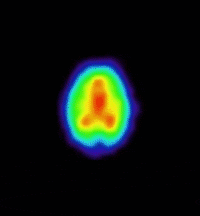Useful links
We have an extensive medicinal chemistry program evaluating structure-activity relationships of a number of molecules varying from polycyclic to heterocyclic scaffolds that interact with specific targets we think are involved in brain disease. The purpose of these studies is to identify lead molecules that can be further developed into drug candidates for the treatment of disease. These projects will involve the synthesis of a series a compounds that aid in the identification of structural motifs responsible for optimizing activity. Some examples are shown below.


(TSPO pharmacophore hypothesis (AHRRR, where A = hydrogen bond acceptor, H = hydrophobic group, and R = ring system). Pink sphere = hydrogen bond acceptor, green sphere = hydrophobic group, tan hoop = ring system.
The translocator protein (TSPO) is ubiquitously expressed in peripheral tissues but only sparingly in the healthy brain. Increased levels of TSPO expression have been noted in neuroinflammatory conditions such as Alzheimer's disease and Parkinson's disease coinciding with activation of microglia. Several TSPO ligands demonstrate neuroprotective properties in animal models of CNS disease making the TSPO an important therapeutic target. Within our group projects involve the discovery and synthesis of novel heterocyclic chemotypes as new TSPO ligands ii) investigation of their structure-activity profile ii) evaluation of the functional activity of all newly synthesised TSPO ligands and their utility as drug candidates.

Activation of P2X7 receptors (P2X7R) by ATP has been shown to stimulate the release of interleukin-1b (IL-1b). Considering that IL-1b can induce behavioural changes that resemble depression and that P2X7R antagonists play an important role in modulating IL-1b, it could be hypothesized that blockade of P2X7Rs might result in antidepressant-like properties. The P2X7R is an unusual non-desensitising cation selective ion channel directly gated by extracellular ATP. This is the most interesting of the ionotropic P2X receptors.
Upon stimulation by high concentrations of ATP it generates a non-selective membrane pore which is permeable to hydrophilic molecules with molecular weight up to 900 Da. Recently a series of polycyclic ligands (examples shown) which displayed potent antagonistic properties at the P2X7 receptor have been reported. Modification of the polycyclic moiety of these molecules represents new exciting lead structures for development of suitable antidepressants.

Since the discovery of sigma receptors, research has been ongoing in an attempt to understand the functional roles of these sites. Initial interest in sigma receptors was largely motivated by the observation that the sigma site was a high affinity binding site for psychoactive drugs including many of the atypical antipsychotic drugs. Ligands which bind with high affinity at sigma receptors have been shown to modulate and interfere with several neurotransmitters and have potent activities in animal models suggestive of antipsychotic, cognitive enhancing, neuroprotective, and antidepressant activities. We have recently reported the synthesis and binding a novel series of trishomocubanes of the type 4-azahexacyclododecane which display high affinity for sigma receptor subtypes. We are currently refining SAR in order to develop higher affinity ligands suitable for in vivo studies of sigma receptor pharmacology.

Animation showing the binding of a sigma receptor ligand in the living baboon brain.
Arylalkyl 4-benzyl piperazines have only recently been developed as radioligands for imaging sigma receptors. This receptor is of interest since many psychoactive drugs including atypical antipsychotics bind to this site. The prototypic radioligand, 1-benzofuran-2-ylmethyl-4-(4-[11C]methoxy-benzyl)piperazine, has been evaluated in the living baboon brain (see images) and has demonstrated in vivo sigma receptor binding. This projects aims at exploring the structure activity profile of the arylalkyl 4-benzyl piperazine scaffold in the development of subtype selective sigma radioligands for imaging using PET.
Our students are encouraged to be active within the international scientific community, and are given the opportunity to attend national and international conferences and collaborate with research groups both in and abroad.
Taking a drug from the discovery phase through to the marketplace requires a substantial investment. Students with a keen interest in drug discovery should contact Professor Kassiou to discuss undertaking future study within the group.
Our group is focused on drug design and synthesis, especially as they relate to lead identification and lead optimisation. Areas of research within our group include, synthetic and medicinal chemistry, in vitro drug screening, and behavioural pharmacology in animal models of human CNS disease states.
